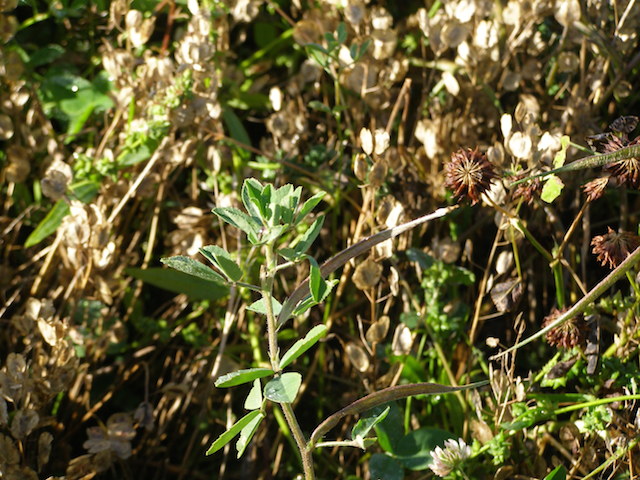Fenugreek & Forage Beets – Telkwa, B.C. 2011 by Curt Gesch
TEFF GRASS, FENUGREEK – Pitt Meadows, B.C. 2010
- I had enough seeds left over from last year to try a small patch. This time I did NOT do any pre-emergent spray or tillage: just a few passes with a rototiller and then I planted according to directions. The seedlings germinated well, but grew slowly. They do not seem bothered by early frosts. By June they were being depressed by weeds, volunteer clovers, etc. I’ve sent a couple pictures. In one you can see a lone fenugreek stem and leaf. In the other the jungle of the competition.
- I would say that—based on two years of tiny trials—that a clean seedbed is the only way to grow this plant. I am not in favour of routine herbicide treatment as a matter of course, but it might be the way to prepare for a seeding. I suspect that a number of pre-plant and pre-emergent tillings would achieve the same thing.
- Also, I know it is a rhizobia-associated plant, but I wonder if some high-N wouldn’t be the thing really get this stuff going so it can shade out competition instead of the other way around.

FORAGE BEETS
- This time I was a little more scientific. I planted relatively long rows of three varieties (see below) and added various sources of calcium cross-row. I had one plot using lumber-mill “wet-ash” and another using “dry-ash” (both from the kilns at a mill) and one plot using calcium carbonate. A fourth plot received no lime and was intended as a control.
- The weather tends to really affect these amateur experiments, and in our case the long, cool, wet summer probably caused skewed results. Also, I did not have replications, bad scientist that I am. The wettest spots germinated and then nearly drowned, and never did really catch up with their neighbouring plants, even within the same plots. There was not much doubt, however, that forage beets, like regular garden beets, respond positively to calcium/lime in nearly any form. The CaC03 plots did best, and then one of the mill ash plots. I based my results solely on visual observation, but there was not much doubt about it. The control plot was lower in productivity. (By the way, my pH is about 6.7.)
FORAGE BEET VARIETIES
- Mammoth Red – This type is probably the easiest to find. If the cows could talk, they’d tell me these are the most palatable (sweetest?) of the varieties I tried. I got them from Johnny’s Selected Seeds, but Jung’s (USA) and a few other companies carry these, too. You can see from the photos that these did not get to the bragging range of 10-20 pounds. I don’t think they could ever get to that size in our cool summer climate. They also had many roots hairs and branches. The ones I grew did not push up out of the ground enough. I had to dig them.
- Golden Eckendorf – I got these from Jung’s Seeds. They did the best in our climate (see photos for average size) with half the root or more out of the ground. I could pick these without digging. I suspect that anyone with a welding torch and some steel could devise an easy-lifting device for these.
- Bucklunch – also from Jung’s. It is being advertised for white-tail deer hunters who maintain food plots. It is white and looks like some winter radishes I’ve seen. In spite of the claim, it did not grow half out of the ground in my tests.
The seed packages all say “110 days” to maturity, but I think that shorter seasons or fewer heat units means simply smaller roots, not that one shouldn’t try growing them. Certainly, our climate (Telkwa) often has a light frost every month and I’m sure the plants will live through those without too much trouble.
It would be great if someone could make a connection with the German company that I found looking under the words “Startseite » Nutz- & Heimtierbedarf » Futtermittelbereitung » Pressen, Quetschen & Stampfer” who produce relatively cheap hand-cranked slicer/choppers. It would be a good demonstration project for our forage people, 4-H clubs, and so on. I’m sure I could find people in our area who’d jump at the chance to try out a new crop and the chopper.
CONCLUSIONS – I will grow the Mammoth Red and Golden Eckendorf again next year. I will add Ca to the soil to all seedings and may experiment with ways to make a temporary storage “pit” above ground with soil, straw, etc.
 See Forage Beet photos here under “Telkwa Trials”.
See Forage Beet photos here under “Telkwa Trials”.
TEFF GRASS – Pitt Meadows, B.C. 2010
Joe Bachmann conducted a small trial with teff grass in the Pitt Meadows area of the Fraser Valley in 2010. Select the link below to see the forage test results for this grass.
Teff grass forage test results (pdf format).

